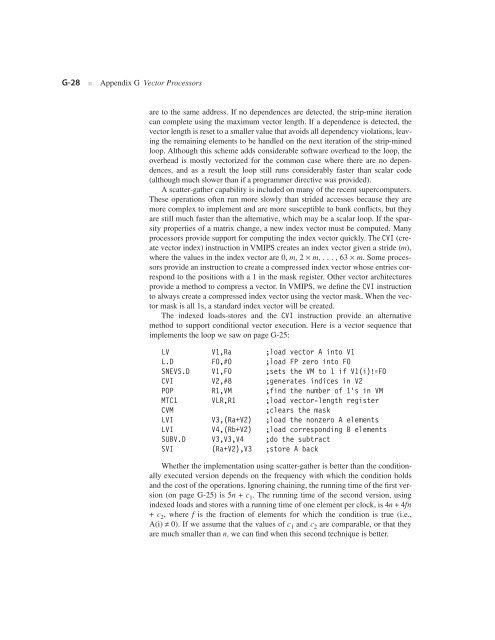Appendix G - Clemson University
Appendix G - Clemson University
Appendix G - Clemson University
Create successful ePaper yourself
Turn your PDF publications into a flip-book with our unique Google optimized e-Paper software.
G-28 ■ <strong>Appendix</strong> G Vector Processors<br />
are to the same address. If no dependences are detected, the strip-mine iteration<br />
can complete using the maximum vector length. If a dependence is detected, the<br />
vector length is reset to a smaller value that avoids all dependency violations, leaving<br />
the remaining elements to be handled on the next iteration of the strip-mined<br />
loop. Although this scheme adds considerable software overhead to the loop, the<br />
overhead is mostly vectorized for the common case where there are no dependences,<br />
and as a result the loop still runs considerably faster than scalar code<br />
(although much slower than if a programmer directive was provided).<br />
A scatter-gather capability is included on many of the recent supercomputers.<br />
These operations often run more slowly than strided accesses because they are<br />
more complex to implement and are more susceptible to bank conflicts, but they<br />
are still much faster than the alternative, which may be a scalar loop. If the sparsity<br />
properties of a matrix change, a new index vector must be computed. Many<br />
processors provide support for computing the index vector quickly. The CVI (create<br />
vector index) instruction in VMIPS creates an index vector given a stride (m),<br />
where the values in the index vector are 0, m, 2 × m, . . . , 63 × m. Some processors<br />
provide an instruction to create a compressed index vector whose entries correspond<br />
to the positions with a 1 in the mask register. Other vector architectures<br />
provide a method to compress a vector. In VMIPS, we define the CVI instruction<br />
to always create a compressed index vector using the vector mask. When the vector<br />
mask is all 1s, a standard index vector will be created.<br />
The indexed loads-stores and the CVI instruction provide an alternative<br />
method to support conditional vector execution. Here is a vector sequence that<br />
implements the loop we saw on page G-25:<br />
LV V1,Ra ;load vector A into V1<br />
L.D F0,#0 ;load FP zero into F0<br />
SNEVS.D V1,F0 ;sets the VM to 1 if V1(i)!=F0<br />
CVI V2,#8 ;generates indices in V2<br />
POP R1,VM ;find the number of 1’s in VM<br />
MTC1 VLR,R1 ;load vector-length register<br />
CVM ;clears the mask<br />
LVI V3,(Ra+V2) ;load the nonzero A elements<br />
LVI V4,(Rb+V2) ;load corresponding B elements<br />
SUBV.D V3,V3,V4 ;do the subtract<br />
SVI (Ra+V2),V3 ;store A back<br />
Whether the implementation using scatter-gather is better than the conditionally<br />
executed version depends on the frequency with which the condition holds<br />
and the cost of the operations. Ignoring chaining, the running time of the first version<br />
(on page G-25) is 5n + c 1 . The running time of the second version, using<br />
indexed loads and stores with a running time of one element per clock, is 4n + 4fn<br />
+ c 2 , where f is the fraction of elements for which the condition is true (i.e.,<br />
A(i) ≠ 0). If we assume that the values of c 1 and c 2 are comparable, or that they<br />
are much smaller than n, we can find when this second technique is better.

















